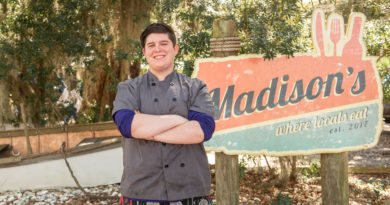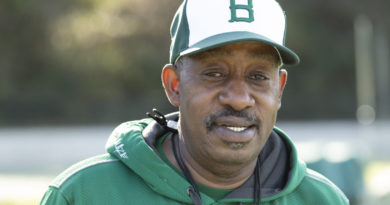Robyn Clevinger:Diving For Treasures And Fun
Story By Mary Ellen Thompson
Photos By John Wollwerth
Once upon a time Wooly Mammoths, Mastodons, and Megalodons remains came to rest in this part of the earth. It sounds like a science fiction fairy tale, but black water diver Robyn Clevinger, can assure you it is not a fantasy. She dives in the rivers in South Carolina, as well as most of east coast states, and finds amazing fossils – huge prehistoric teeth and skeletal remains of these ancient creatures that are nestled in our river and creek beds. Robyn explains that these remains are here, not because they are indigenous, but because every culture documents a great flood and they got deposited all over.
“At first, I started looking for teeth so I got a salvage license and a permit. The first tooth I found was in Georgia. Regulations differ by state but in South Carolina your permit requires that you keep a log which has to be turned in quarterly. The state may take any artifacts you find; consequently many divers do not seek permits and report what they find. In the beginning I used the pieces I found to acquire my diving gear. I’ve donated many items to fundraisers for breast cancer, cystic fibrosis and the Wounded Warrior Program. A near perfect seven inch tooth once sold in auction for thousands of dollars. I take the pieces to schools also and have given pieces to children as well other individuals who have a keen interest.” Robyn explains, “There is nothing like seeing the joy on someone’s face when you let them pick a piece to keep for themselves.”
Not only does she find bones and teeth, but also lots of other artifacts from the civilizations that existed here in the lowcountry. Her collection includes parts of Native American/Indian smoke pipe stems, pottery shards and some nearly whole pieces, and old bottles. Other treasures include sting ray barbs, whale teeth, whale bones, assorted vessels, a key and some broken pieces of jewelry. She has baskets and buckets of bones, vertebrae, teeth, and the more difficult to identify – fossilized whale poop. She’s found some ancient sand dollars the size of dinner plates, and shark teeth 60 – 80 feet long. “Different sedimentary layers hold different things, bones will be in one, teeth in another. Some bottles are covered in barnacles because they’re found nearer to the surface and they’ve been exposed to air; the ones that have never been exposed have a slick surface.”
Finding these artifacts is not for the faint of heart, it’s extremely difficult to dive in water where you can barely see your hand in front of your face, which is why it is called “black water diving”. Robyn describes it like this, “You have a brief window: imagine being in a pitch black room with water swirling all around you. When you turn on your flashlight, everything looks foggy. You’re wearing gloves and feeling around in the mud, when you’re digging your fingers in and you’re actually fanning the bottom to get the water to rise up off the bottom in the current. It’s just about impossible to see, so you’re relying heavily on your sense of feel. In these waters you work hard to fight the current and consequently need to wear extra weights.”
What in the world induced a small framed, very feminine, woman to want to risk her life to explore the remains of extinct gigantic creatures? “I’m an adventurer! I love scuba diving – for me it’s freeing. It makes me very happy.” Adventurer is probably an understatement – the woman is fearless. In 2003, Robyn got certified for search and rescue and is a member of the Beaufort Search and Rescue Team, which means she dives to retrieve victims of drownings.
Robyn has also served as a volunteer diver for the South Carolina Aquarium. “The aquarium is great. It’s not only a place where people can learn about the animals native to our area but they also help rehabilitate sea life and release animals back into their natural habitat.” It was also pretty neat to see the look on a child’s face when you locked eyes with them as they gazed through the glass of the tank.”
This is the stuff reality TV shows, History, Discovery and Science Channels are made of, literally. Her expertise at diving and her reputation for finding things, were recognized by Discovery’s Science Channel and she was part of the team that filmed the documentary America’s Lost H Bomb. “When we were filming, we were diving off the coast of Tybee Island. We took bottom samples that were tested for radiation levels and dove multiple underwater searches of the area. At one point the area was surrounded by government boats with men wearing all black, they took over the site and dove day and night for weeks. Finally they released the site back to us but we didn’t find anything.” What, exactly, were they looking for? According to Marabella Productions and Discovery’s Science Channel: “THERE’S A MISSING WMD, but you’d never guess where… In 1958, a damaged U.S. B-47 bomber jettisons a nuclear bomb off the coast of Savannah Georgia containing 350 pounds of conventional explosives and an undisclosed quantity of highly enriched uranium. The bomb’s explosive yield is 100 times that of the Hiroshima bomb For weeks, the U.S. Navy and Air Force searched for the bomb in the silty waters around Tybee Island. Deemed ‘irretrievably lost,’ the 7,600 pound nuclear Tybee bomb is still out there…” Robyn states, “We got to interview the pilot, he took us to the locations and recounted the night of that infamous flight. It was amazing to hear him recount the details like it was yesterday.” She has participated in multiple shows about diving for artifacts and fossils in dark water as well as something new is in the works with Discovery that is currently being kept quiet until it airs this fall.
Ancient creature remains, nuclear bombs, underwater currents, practically zero visibility, and sharks all abound in her environment. What is the most dangerous element of diving here? “Alligators!” Robyn explains, “There are alligators all over the place here in the rivers. I don’t mind the sharks, a shark might take a bite out of you and decide you are not in it’s food chain but an alligator will bite and roll without the intent to every let go; I try never to dive if I see an alligator during mating season because they get really aggressive. I had an encounter with an eight foot alligator; I was underwater in a submerged tree, my arms and legs were over a limb when I felt something on my back. We dive in groups and we always joke around with each other, pulling fins and stuff, so I thought it was one of the guys so I jabbed my elbow back. Then I sensed feet in front of my shoulders and behind my legs and then I felt the tail go over my head! I knew I needed to get out of there but I didn’t know where it had gone or if it was coming back. When I did get to the surface and over to the boat, the guys in the boat asked if I’d seen that eight foot alligator that followed me into the water. They should have warned me that he was there because they saw him slide off the bank after me when I went in. “But it all turned out okay”, she laughs.
“I enjoy sightseeing too, but I prefer searching for ‘treasures’ in dark water.” Sightseeing is what Robyn explains as clear water diving where you can see everything around you. She’s been to several foreign countries as well as areas in the states to clear water dive but even when she dives clear water she seeks out the “local treasures.” “Local treasures are those things that you aren’t able to find somewhere else”, she explains. “I always go with a list of things to look for that I can’t find elsewhere so in a sense I am still treasure hunting.”
Equally at home above and below the water, Robyn is woman of many talents. Although she is self-taught in the field of archeology, Robyn has a degree in Business Management which comes in handy to help fund her diving passion. She gives financial presentations for members in the military, and she and her husband, Craig Valentine, also have a mariculture clam plantation and nearly 100 acres where they farm and cultivate oysters in the local rivers. Her devotion to exploration and her underwater findings are constantly bringing history from the dark recesses where they have been resting, to the light of present day.



